Detailed Observational Report on Child's Cognitive Development
VerifiedAdded on 2023/05/30
|14
|3212
|66
Report
AI Summary
This report presents an observational study of a child's cognitive development, focusing on various milestones and stages as the child grows. The observations are interpreted through the lens of prominent developmental theories, including Piaget's stages of cognitive development, Bowlby's attachment theory, and Erikson's psychosocial development theory. The report details the child's progression from simple reflexes and sensory-motor skills to preoperational thought, language development, and social interaction. Specific instances of the child's behavior, such as object recognition, problem-solving, imitation, and interaction with others, are analyzed to illustrate the development of cognitive abilities and social understanding. The study highlights the interplay between physical growth, cognitive skills, and emotional attachments in shaping the child's overall development, providing a comprehensive overview of the key developmental processes during early childhood.
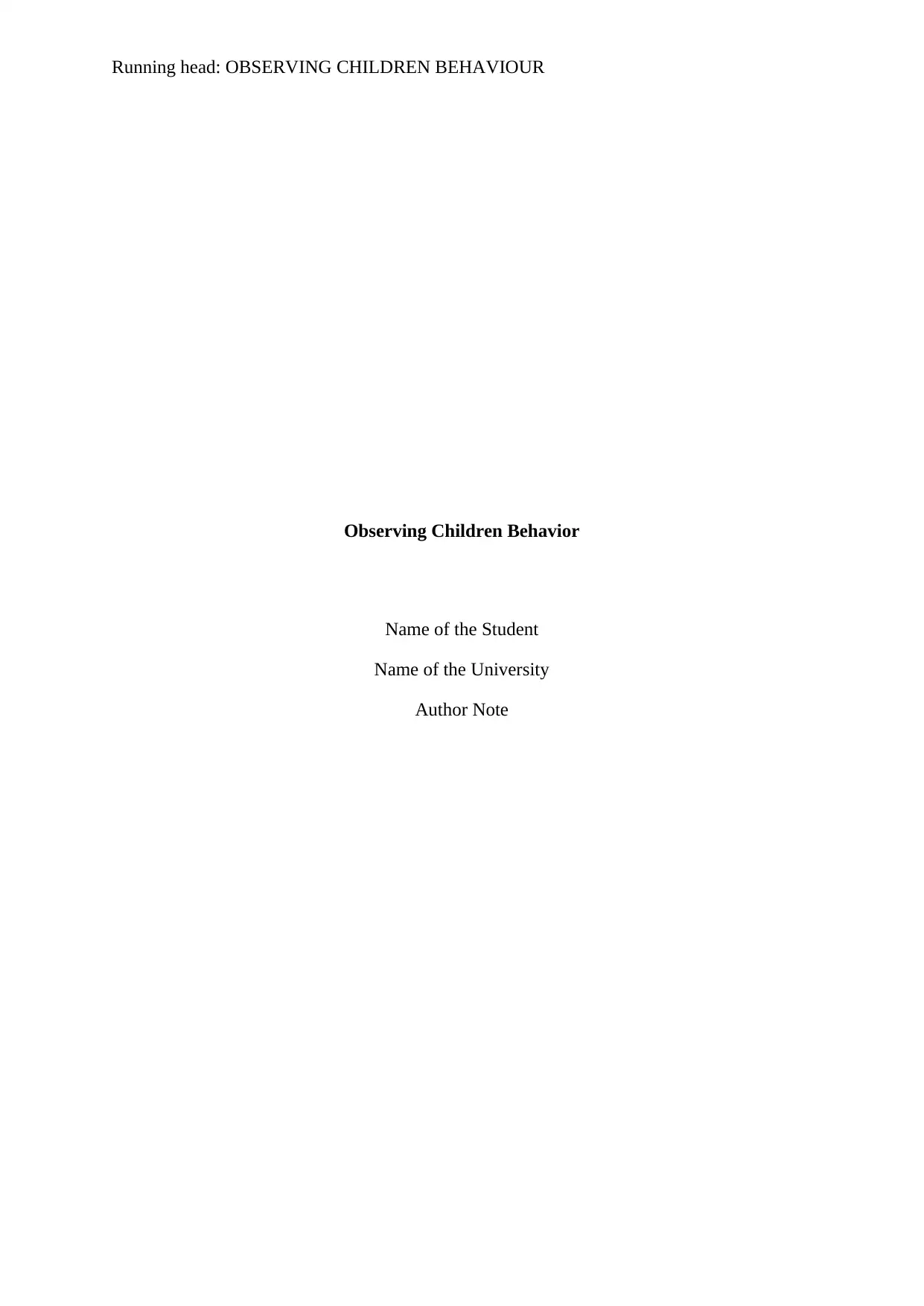
Running head: OBSERVING CHILDREN BEHAVIOUR
Observing Children Behavior
Name of the Student
Name of the University
Author Note
Observing Children Behavior
Name of the Student
Name of the University
Author Note
Paraphrase This Document
Need a fresh take? Get an instant paraphrase of this document with our AI Paraphraser
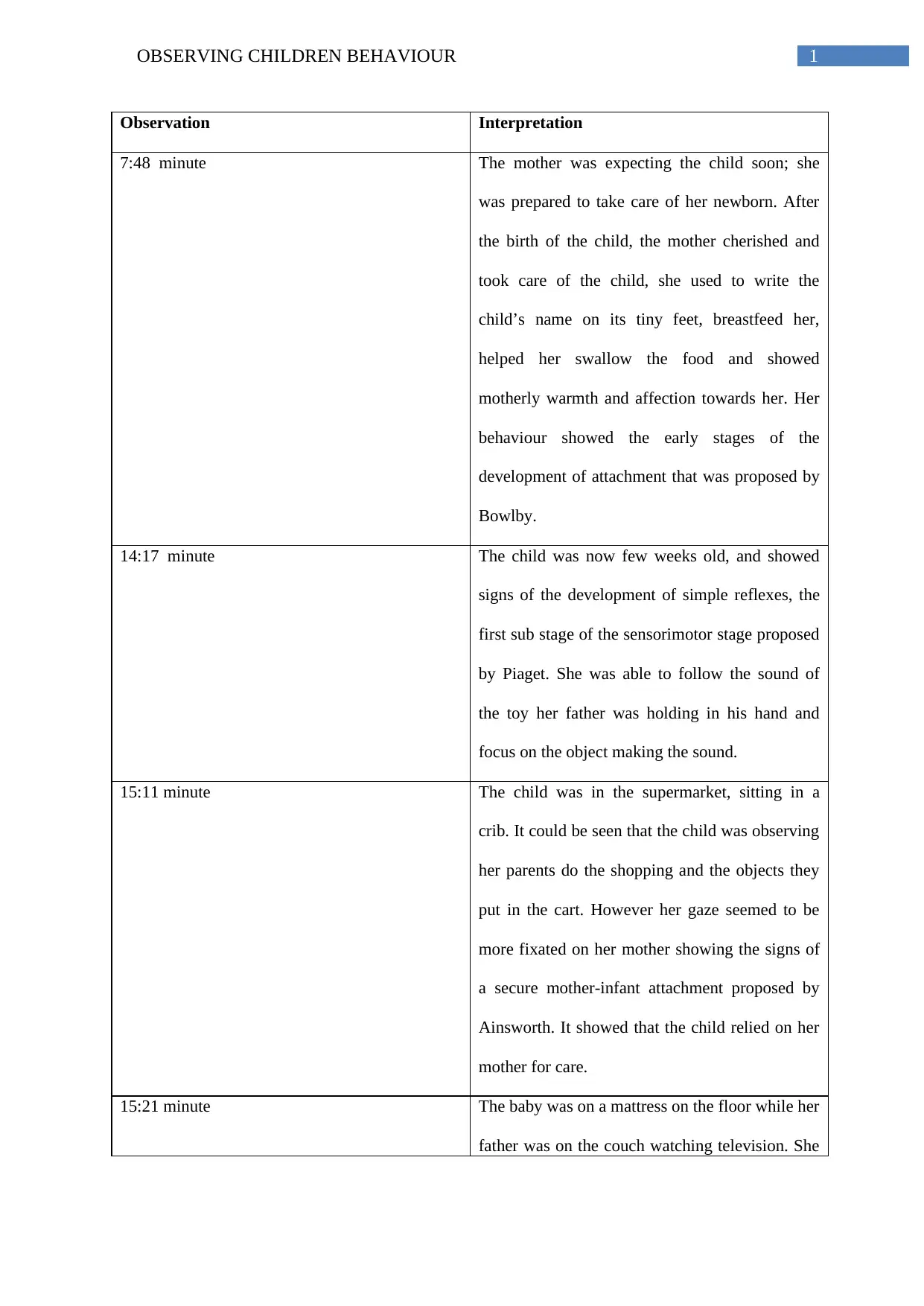
1OBSERVING CHILDREN BEHAVIOUR
Observation Interpretation
7:48 minute The mother was expecting the child soon; she
was prepared to take care of her newborn. After
the birth of the child, the mother cherished and
took care of the child, she used to write the
child’s name on its tiny feet, breastfeed her,
helped her swallow the food and showed
motherly warmth and affection towards her. Her
behaviour showed the early stages of the
development of attachment that was proposed by
Bowlby.
14:17 minute The child was now few weeks old, and showed
signs of the development of simple reflexes, the
first sub stage of the sensorimotor stage proposed
by Piaget. She was able to follow the sound of
the toy her father was holding in his hand and
focus on the object making the sound.
15:11 minute The child was in the supermarket, sitting in a
crib. It could be seen that the child was observing
her parents do the shopping and the objects they
put in the cart. However her gaze seemed to be
more fixated on her mother showing the signs of
a secure mother-infant attachment proposed by
Ainsworth. It showed that the child relied on her
mother for care.
15:21 minute The baby was on a mattress on the floor while her
father was on the couch watching television. She
Observation Interpretation
7:48 minute The mother was expecting the child soon; she
was prepared to take care of her newborn. After
the birth of the child, the mother cherished and
took care of the child, she used to write the
child’s name on its tiny feet, breastfeed her,
helped her swallow the food and showed
motherly warmth and affection towards her. Her
behaviour showed the early stages of the
development of attachment that was proposed by
Bowlby.
14:17 minute The child was now few weeks old, and showed
signs of the development of simple reflexes, the
first sub stage of the sensorimotor stage proposed
by Piaget. She was able to follow the sound of
the toy her father was holding in his hand and
focus on the object making the sound.
15:11 minute The child was in the supermarket, sitting in a
crib. It could be seen that the child was observing
her parents do the shopping and the objects they
put in the cart. However her gaze seemed to be
more fixated on her mother showing the signs of
a secure mother-infant attachment proposed by
Ainsworth. It showed that the child relied on her
mother for care.
15:21 minute The baby was on a mattress on the floor while her
father was on the couch watching television. She
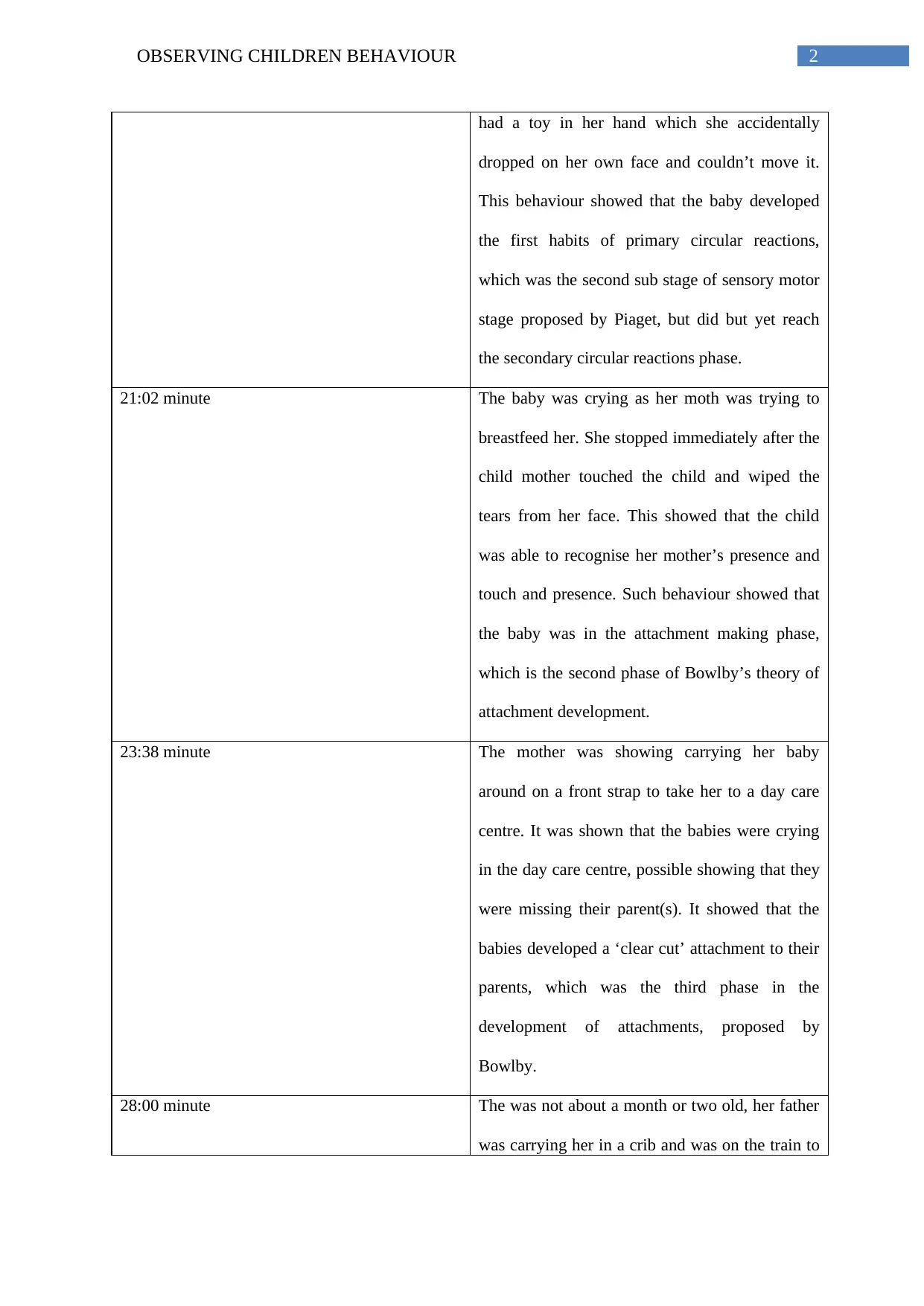
2OBSERVING CHILDREN BEHAVIOUR
had a toy in her hand which she accidentally
dropped on her own face and couldn’t move it.
This behaviour showed that the baby developed
the first habits of primary circular reactions,
which was the second sub stage of sensory motor
stage proposed by Piaget, but did but yet reach
the secondary circular reactions phase.
21:02 minute The baby was crying as her moth was trying to
breastfeed her. She stopped immediately after the
child mother touched the child and wiped the
tears from her face. This showed that the child
was able to recognise her mother’s presence and
touch and presence. Such behaviour showed that
the baby was in the attachment making phase,
which is the second phase of Bowlby’s theory of
attachment development.
23:38 minute The mother was showing carrying her baby
around on a front strap to take her to a day care
centre. It was shown that the babies were crying
in the day care centre, possible showing that they
were missing their parent(s). It showed that the
babies developed a ‘clear cut’ attachment to their
parents, which was the third phase in the
development of attachments, proposed by
Bowlby.
28:00 minute The was not about a month or two old, her father
was carrying her in a crib and was on the train to
had a toy in her hand which she accidentally
dropped on her own face and couldn’t move it.
This behaviour showed that the baby developed
the first habits of primary circular reactions,
which was the second sub stage of sensory motor
stage proposed by Piaget, but did but yet reach
the secondary circular reactions phase.
21:02 minute The baby was crying as her moth was trying to
breastfeed her. She stopped immediately after the
child mother touched the child and wiped the
tears from her face. This showed that the child
was able to recognise her mother’s presence and
touch and presence. Such behaviour showed that
the baby was in the attachment making phase,
which is the second phase of Bowlby’s theory of
attachment development.
23:38 minute The mother was showing carrying her baby
around on a front strap to take her to a day care
centre. It was shown that the babies were crying
in the day care centre, possible showing that they
were missing their parent(s). It showed that the
babies developed a ‘clear cut’ attachment to their
parents, which was the third phase in the
development of attachments, proposed by
Bowlby.
28:00 minute The was not about a month or two old, her father
was carrying her in a crib and was on the train to
⊘ This is a preview!⊘
Do you want full access?
Subscribe today to unlock all pages.

Trusted by 1+ million students worldwide
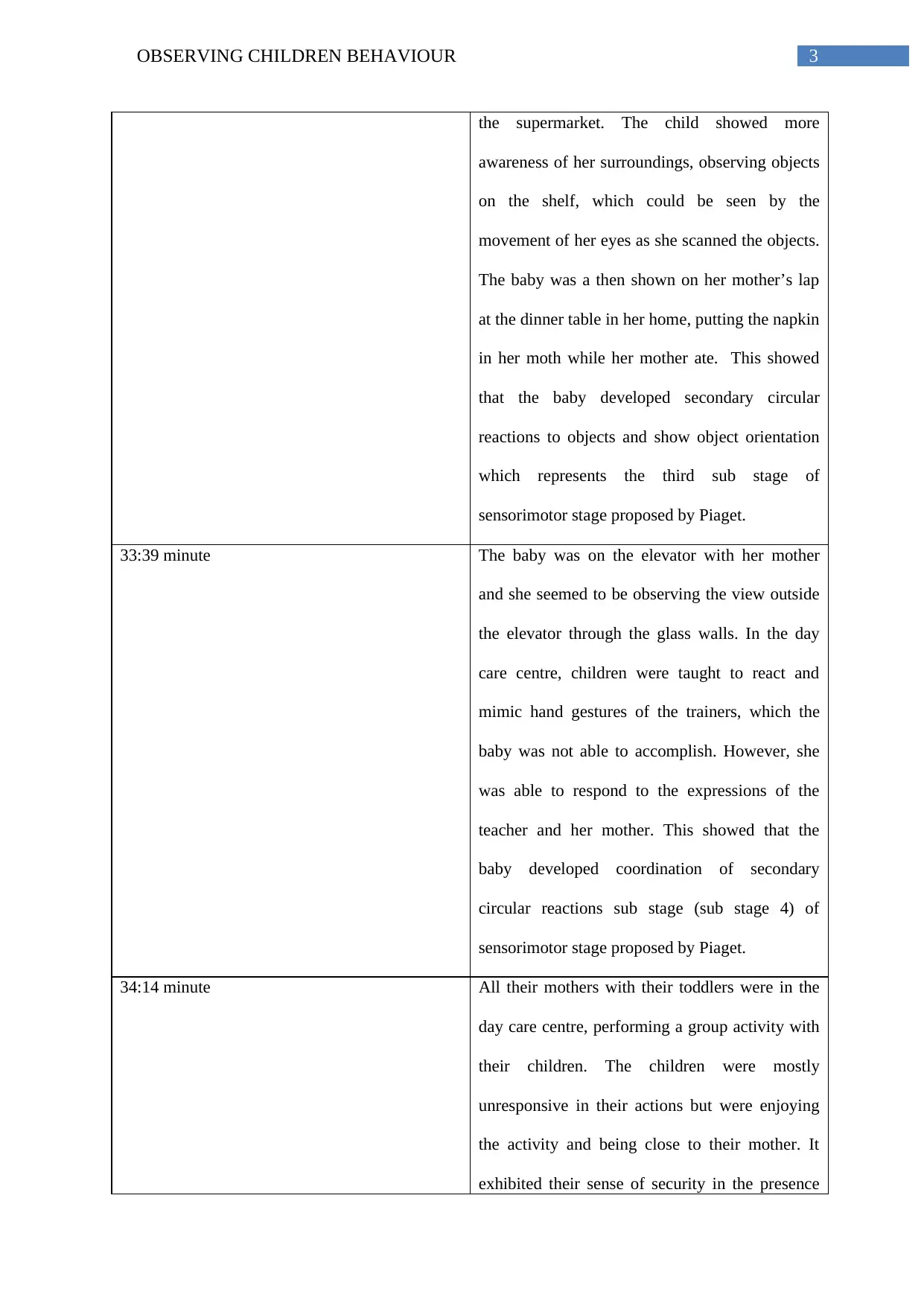
3OBSERVING CHILDREN BEHAVIOUR
the supermarket. The child showed more
awareness of her surroundings, observing objects
on the shelf, which could be seen by the
movement of her eyes as she scanned the objects.
The baby was a then shown on her mother’s lap
at the dinner table in her home, putting the napkin
in her moth while her mother ate. This showed
that the baby developed secondary circular
reactions to objects and show object orientation
which represents the third sub stage of
sensorimotor stage proposed by Piaget.
33:39 minute The baby was on the elevator with her mother
and she seemed to be observing the view outside
the elevator through the glass walls. In the day
care centre, children were taught to react and
mimic hand gestures of the trainers, which the
baby was not able to accomplish. However, she
was able to respond to the expressions of the
teacher and her mother. This showed that the
baby developed coordination of secondary
circular reactions sub stage (sub stage 4) of
sensorimotor stage proposed by Piaget.
34:14 minute All their mothers with their toddlers were in the
day care centre, performing a group activity with
their children. The children were mostly
unresponsive in their actions but were enjoying
the activity and being close to their mother. It
exhibited their sense of security in the presence
the supermarket. The child showed more
awareness of her surroundings, observing objects
on the shelf, which could be seen by the
movement of her eyes as she scanned the objects.
The baby was a then shown on her mother’s lap
at the dinner table in her home, putting the napkin
in her moth while her mother ate. This showed
that the baby developed secondary circular
reactions to objects and show object orientation
which represents the third sub stage of
sensorimotor stage proposed by Piaget.
33:39 minute The baby was on the elevator with her mother
and she seemed to be observing the view outside
the elevator through the glass walls. In the day
care centre, children were taught to react and
mimic hand gestures of the trainers, which the
baby was not able to accomplish. However, she
was able to respond to the expressions of the
teacher and her mother. This showed that the
baby developed coordination of secondary
circular reactions sub stage (sub stage 4) of
sensorimotor stage proposed by Piaget.
34:14 minute All their mothers with their toddlers were in the
day care centre, performing a group activity with
their children. The children were mostly
unresponsive in their actions but were enjoying
the activity and being close to their mother. It
exhibited their sense of security in the presence
Paraphrase This Document
Need a fresh take? Get an instant paraphrase of this document with our AI Paraphraser
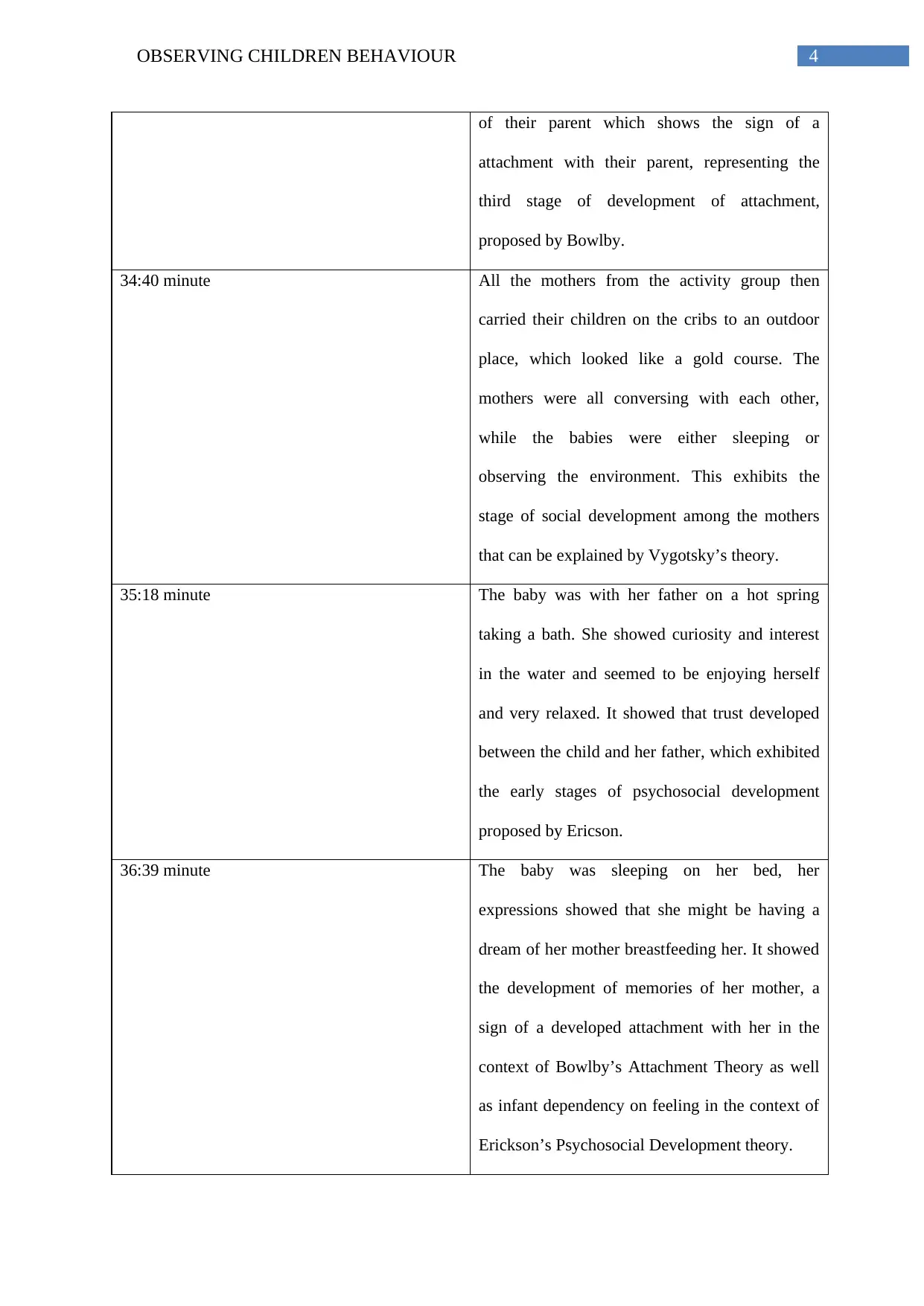
4OBSERVING CHILDREN BEHAVIOUR
of their parent which shows the sign of a
attachment with their parent, representing the
third stage of development of attachment,
proposed by Bowlby.
34:40 minute All the mothers from the activity group then
carried their children on the cribs to an outdoor
place, which looked like a gold course. The
mothers were all conversing with each other,
while the babies were either sleeping or
observing the environment. This exhibits the
stage of social development among the mothers
that can be explained by Vygotsky’s theory.
35:18 minute The baby was with her father on a hot spring
taking a bath. She showed curiosity and interest
in the water and seemed to be enjoying herself
and very relaxed. It showed that trust developed
between the child and her father, which exhibited
the early stages of psychosocial development
proposed by Ericson.
36:39 minute The baby was sleeping on her bed, her
expressions showed that she might be having a
dream of her mother breastfeeding her. It showed
the development of memories of her mother, a
sign of a developed attachment with her in the
context of Bowlby’s Attachment Theory as well
as infant dependency on feeling in the context of
Erickson’s Psychosocial Development theory.
of their parent which shows the sign of a
attachment with their parent, representing the
third stage of development of attachment,
proposed by Bowlby.
34:40 minute All the mothers from the activity group then
carried their children on the cribs to an outdoor
place, which looked like a gold course. The
mothers were all conversing with each other,
while the babies were either sleeping or
observing the environment. This exhibits the
stage of social development among the mothers
that can be explained by Vygotsky’s theory.
35:18 minute The baby was with her father on a hot spring
taking a bath. She showed curiosity and interest
in the water and seemed to be enjoying herself
and very relaxed. It showed that trust developed
between the child and her father, which exhibited
the early stages of psychosocial development
proposed by Ericson.
36:39 minute The baby was sleeping on her bed, her
expressions showed that she might be having a
dream of her mother breastfeeding her. It showed
the development of memories of her mother, a
sign of a developed attachment with her in the
context of Bowlby’s Attachment Theory as well
as infant dependency on feeling in the context of
Erickson’s Psychosocial Development theory.
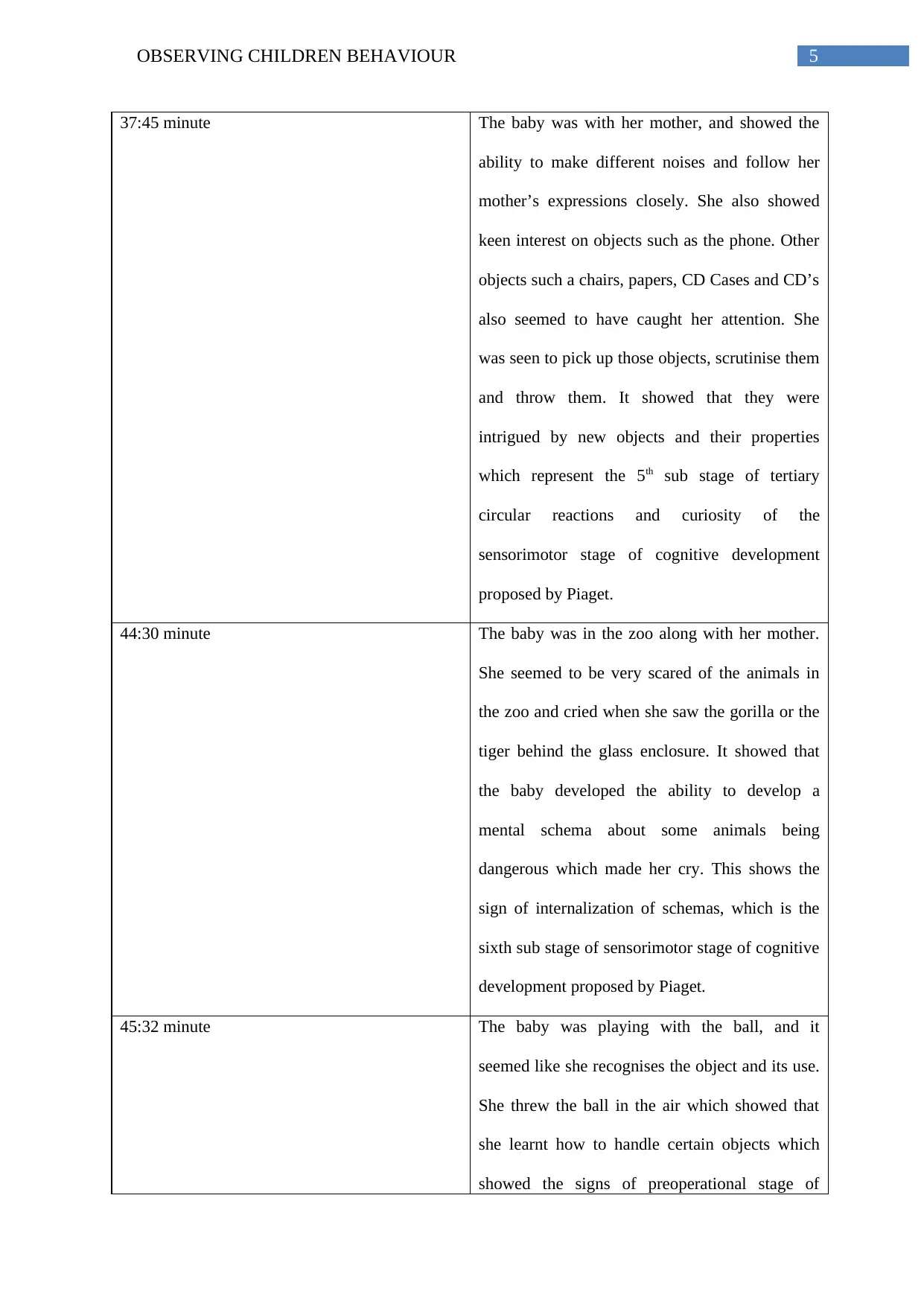
5OBSERVING CHILDREN BEHAVIOUR
37:45 minute The baby was with her mother, and showed the
ability to make different noises and follow her
mother’s expressions closely. She also showed
keen interest on objects such as the phone. Other
objects such a chairs, papers, CD Cases and CD’s
also seemed to have caught her attention. She
was seen to pick up those objects, scrutinise them
and throw them. It showed that they were
intrigued by new objects and their properties
which represent the 5th sub stage of tertiary
circular reactions and curiosity of the
sensorimotor stage of cognitive development
proposed by Piaget.
44:30 minute The baby was in the zoo along with her mother.
She seemed to be very scared of the animals in
the zoo and cried when she saw the gorilla or the
tiger behind the glass enclosure. It showed that
the baby developed the ability to develop a
mental schema about some animals being
dangerous which made her cry. This shows the
sign of internalization of schemas, which is the
sixth sub stage of sensorimotor stage of cognitive
development proposed by Piaget.
45:32 minute The baby was playing with the ball, and it
seemed like she recognises the object and its use.
She threw the ball in the air which showed that
she learnt how to handle certain objects which
showed the signs of preoperational stage of
37:45 minute The baby was with her mother, and showed the
ability to make different noises and follow her
mother’s expressions closely. She also showed
keen interest on objects such as the phone. Other
objects such a chairs, papers, CD Cases and CD’s
also seemed to have caught her attention. She
was seen to pick up those objects, scrutinise them
and throw them. It showed that they were
intrigued by new objects and their properties
which represent the 5th sub stage of tertiary
circular reactions and curiosity of the
sensorimotor stage of cognitive development
proposed by Piaget.
44:30 minute The baby was in the zoo along with her mother.
She seemed to be very scared of the animals in
the zoo and cried when she saw the gorilla or the
tiger behind the glass enclosure. It showed that
the baby developed the ability to develop a
mental schema about some animals being
dangerous which made her cry. This shows the
sign of internalization of schemas, which is the
sixth sub stage of sensorimotor stage of cognitive
development proposed by Piaget.
45:32 minute The baby was playing with the ball, and it
seemed like she recognises the object and its use.
She threw the ball in the air which showed that
she learnt how to handle certain objects which
showed the signs of preoperational stage of
⊘ This is a preview!⊘
Do you want full access?
Subscribe today to unlock all pages.

Trusted by 1+ million students worldwide
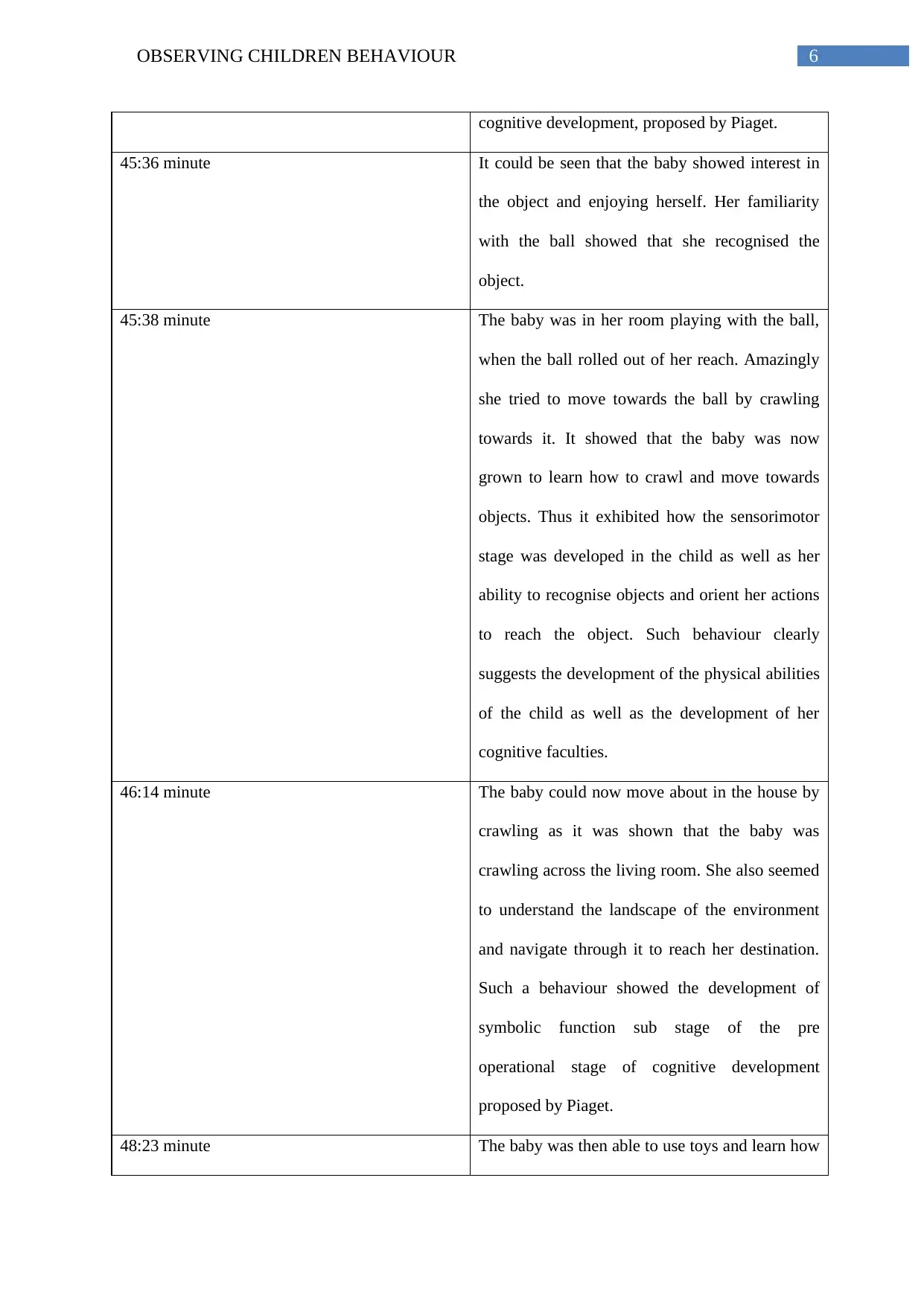
6OBSERVING CHILDREN BEHAVIOUR
cognitive development, proposed by Piaget.
45:36 minute It could be seen that the baby showed interest in
the object and enjoying herself. Her familiarity
with the ball showed that she recognised the
object.
45:38 minute The baby was in her room playing with the ball,
when the ball rolled out of her reach. Amazingly
she tried to move towards the ball by crawling
towards it. It showed that the baby was now
grown to learn how to crawl and move towards
objects. Thus it exhibited how the sensorimotor
stage was developed in the child as well as her
ability to recognise objects and orient her actions
to reach the object. Such behaviour clearly
suggests the development of the physical abilities
of the child as well as the development of her
cognitive faculties.
46:14 minute The baby could now move about in the house by
crawling as it was shown that the baby was
crawling across the living room. She also seemed
to understand the landscape of the environment
and navigate through it to reach her destination.
Such a behaviour showed the development of
symbolic function sub stage of the pre
operational stage of cognitive development
proposed by Piaget.
48:23 minute The baby was then able to use toys and learn how
cognitive development, proposed by Piaget.
45:36 minute It could be seen that the baby showed interest in
the object and enjoying herself. Her familiarity
with the ball showed that she recognised the
object.
45:38 minute The baby was in her room playing with the ball,
when the ball rolled out of her reach. Amazingly
she tried to move towards the ball by crawling
towards it. It showed that the baby was now
grown to learn how to crawl and move towards
objects. Thus it exhibited how the sensorimotor
stage was developed in the child as well as her
ability to recognise objects and orient her actions
to reach the object. Such behaviour clearly
suggests the development of the physical abilities
of the child as well as the development of her
cognitive faculties.
46:14 minute The baby could now move about in the house by
crawling as it was shown that the baby was
crawling across the living room. She also seemed
to understand the landscape of the environment
and navigate through it to reach her destination.
Such a behaviour showed the development of
symbolic function sub stage of the pre
operational stage of cognitive development
proposed by Piaget.
48:23 minute The baby was then able to use toys and learn how
Paraphrase This Document
Need a fresh take? Get an instant paraphrase of this document with our AI Paraphraser
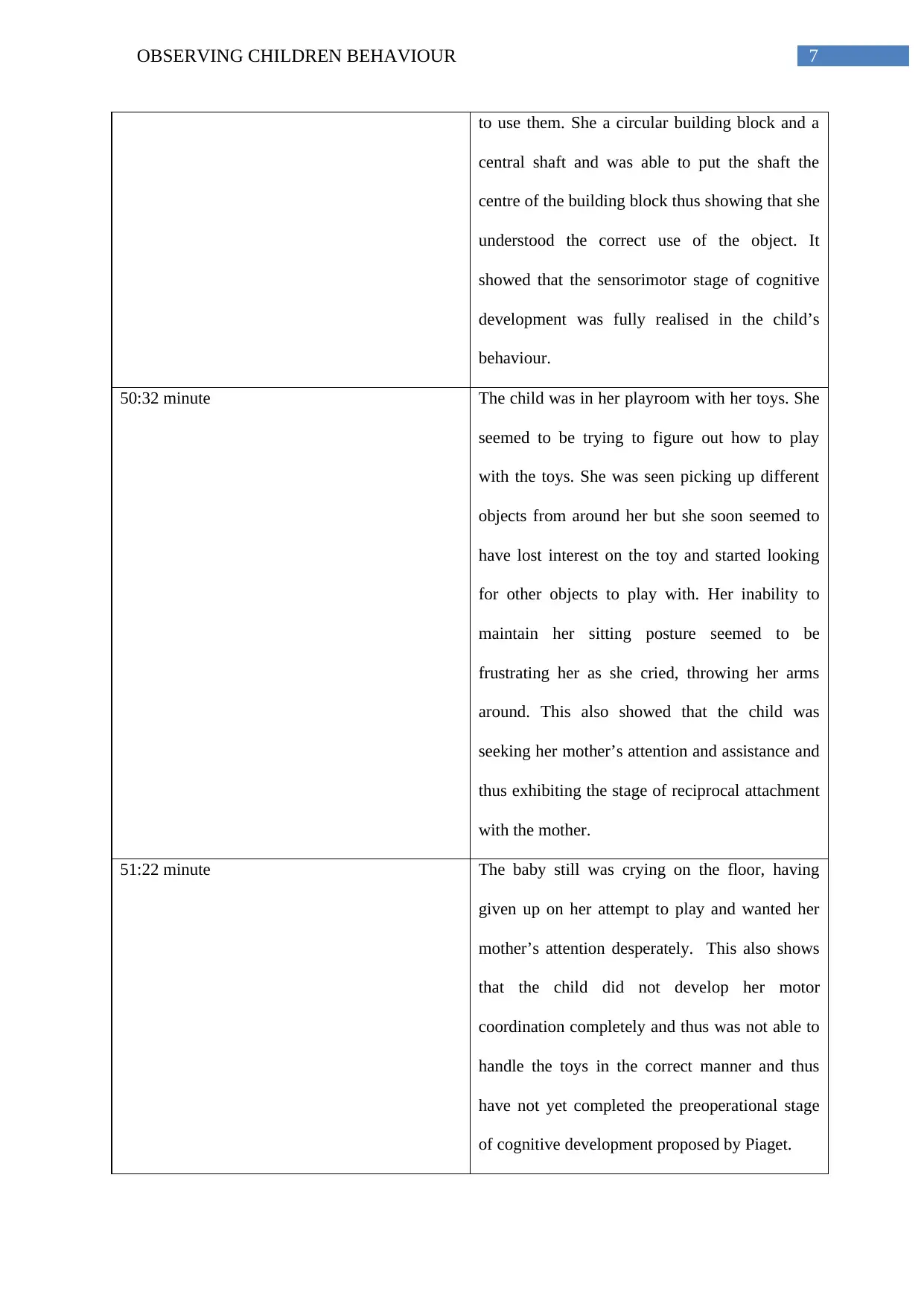
7OBSERVING CHILDREN BEHAVIOUR
to use them. She a circular building block and a
central shaft and was able to put the shaft the
centre of the building block thus showing that she
understood the correct use of the object. It
showed that the sensorimotor stage of cognitive
development was fully realised in the child’s
behaviour.
50:32 minute The child was in her playroom with her toys. She
seemed to be trying to figure out how to play
with the toys. She was seen picking up different
objects from around her but she soon seemed to
have lost interest on the toy and started looking
for other objects to play with. Her inability to
maintain her sitting posture seemed to be
frustrating her as she cried, throwing her arms
around. This also showed that the child was
seeking her mother’s attention and assistance and
thus exhibiting the stage of reciprocal attachment
with the mother.
51:22 minute The baby still was crying on the floor, having
given up on her attempt to play and wanted her
mother’s attention desperately. This also shows
that the child did not develop her motor
coordination completely and thus was not able to
handle the toys in the correct manner and thus
have not yet completed the preoperational stage
of cognitive development proposed by Piaget.
to use them. She a circular building block and a
central shaft and was able to put the shaft the
centre of the building block thus showing that she
understood the correct use of the object. It
showed that the sensorimotor stage of cognitive
development was fully realised in the child’s
behaviour.
50:32 minute The child was in her playroom with her toys. She
seemed to be trying to figure out how to play
with the toys. She was seen picking up different
objects from around her but she soon seemed to
have lost interest on the toy and started looking
for other objects to play with. Her inability to
maintain her sitting posture seemed to be
frustrating her as she cried, throwing her arms
around. This also showed that the child was
seeking her mother’s attention and assistance and
thus exhibiting the stage of reciprocal attachment
with the mother.
51:22 minute The baby still was crying on the floor, having
given up on her attempt to play and wanted her
mother’s attention desperately. This also shows
that the child did not develop her motor
coordination completely and thus was not able to
handle the toys in the correct manner and thus
have not yet completed the preoperational stage
of cognitive development proposed by Piaget.
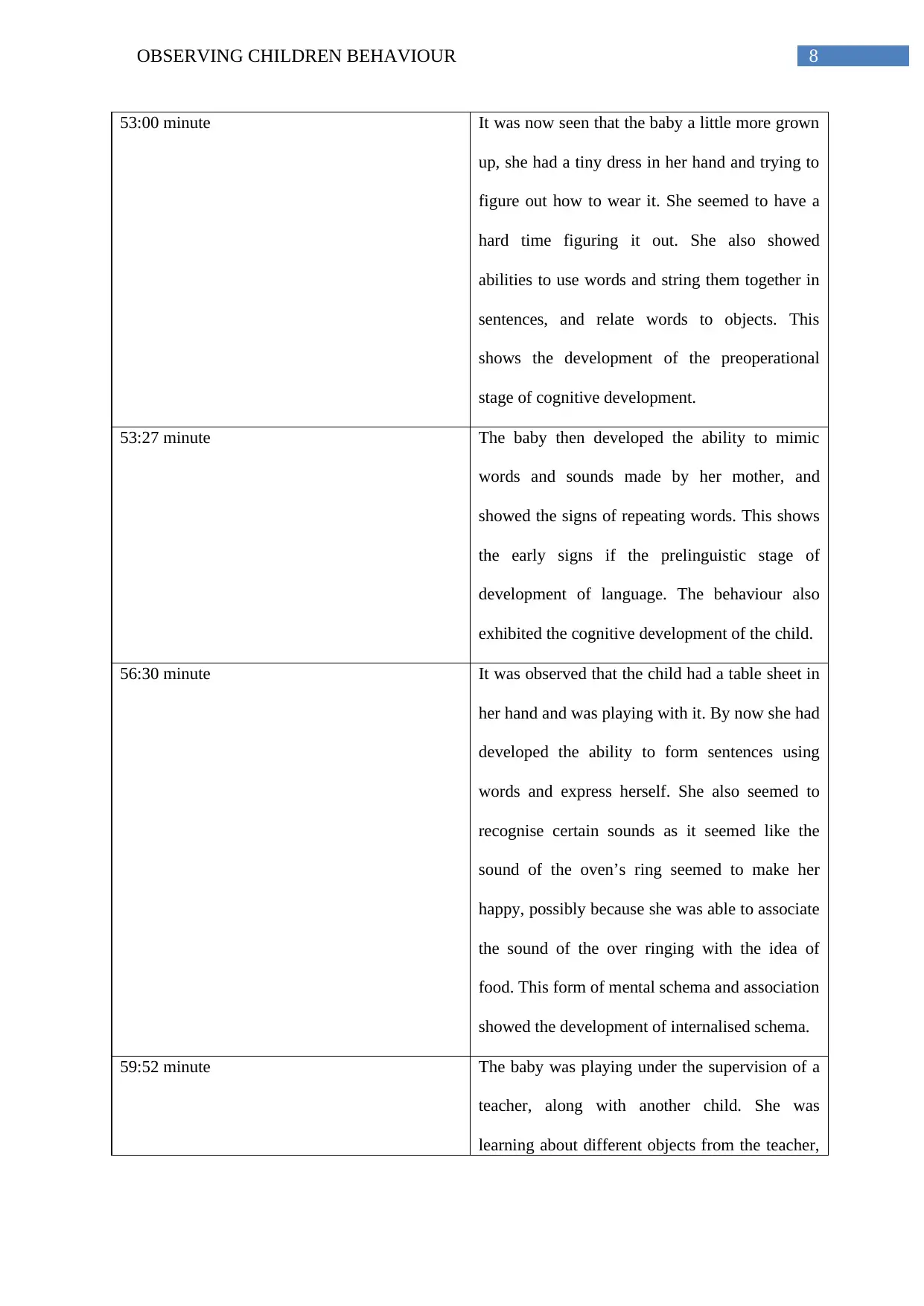
8OBSERVING CHILDREN BEHAVIOUR
53:00 minute It was now seen that the baby a little more grown
up, she had a tiny dress in her hand and trying to
figure out how to wear it. She seemed to have a
hard time figuring it out. She also showed
abilities to use words and string them together in
sentences, and relate words to objects. This
shows the development of the preoperational
stage of cognitive development.
53:27 minute The baby then developed the ability to mimic
words and sounds made by her mother, and
showed the signs of repeating words. This shows
the early signs if the prelinguistic stage of
development of language. The behaviour also
exhibited the cognitive development of the child.
56:30 minute It was observed that the child had a table sheet in
her hand and was playing with it. By now she had
developed the ability to form sentences using
words and express herself. She also seemed to
recognise certain sounds as it seemed like the
sound of the oven’s ring seemed to make her
happy, possibly because she was able to associate
the sound of the over ringing with the idea of
food. This form of mental schema and association
showed the development of internalised schema.
59:52 minute The baby was playing under the supervision of a
teacher, along with another child. She was
learning about different objects from the teacher,
53:00 minute It was now seen that the baby a little more grown
up, she had a tiny dress in her hand and trying to
figure out how to wear it. She seemed to have a
hard time figuring it out. She also showed
abilities to use words and string them together in
sentences, and relate words to objects. This
shows the development of the preoperational
stage of cognitive development.
53:27 minute The baby then developed the ability to mimic
words and sounds made by her mother, and
showed the signs of repeating words. This shows
the early signs if the prelinguistic stage of
development of language. The behaviour also
exhibited the cognitive development of the child.
56:30 minute It was observed that the child had a table sheet in
her hand and was playing with it. By now she had
developed the ability to form sentences using
words and express herself. She also seemed to
recognise certain sounds as it seemed like the
sound of the oven’s ring seemed to make her
happy, possibly because she was able to associate
the sound of the over ringing with the idea of
food. This form of mental schema and association
showed the development of internalised schema.
59:52 minute The baby was playing under the supervision of a
teacher, along with another child. She was
learning about different objects from the teacher,
⊘ This is a preview!⊘
Do you want full access?
Subscribe today to unlock all pages.

Trusted by 1+ million students worldwide
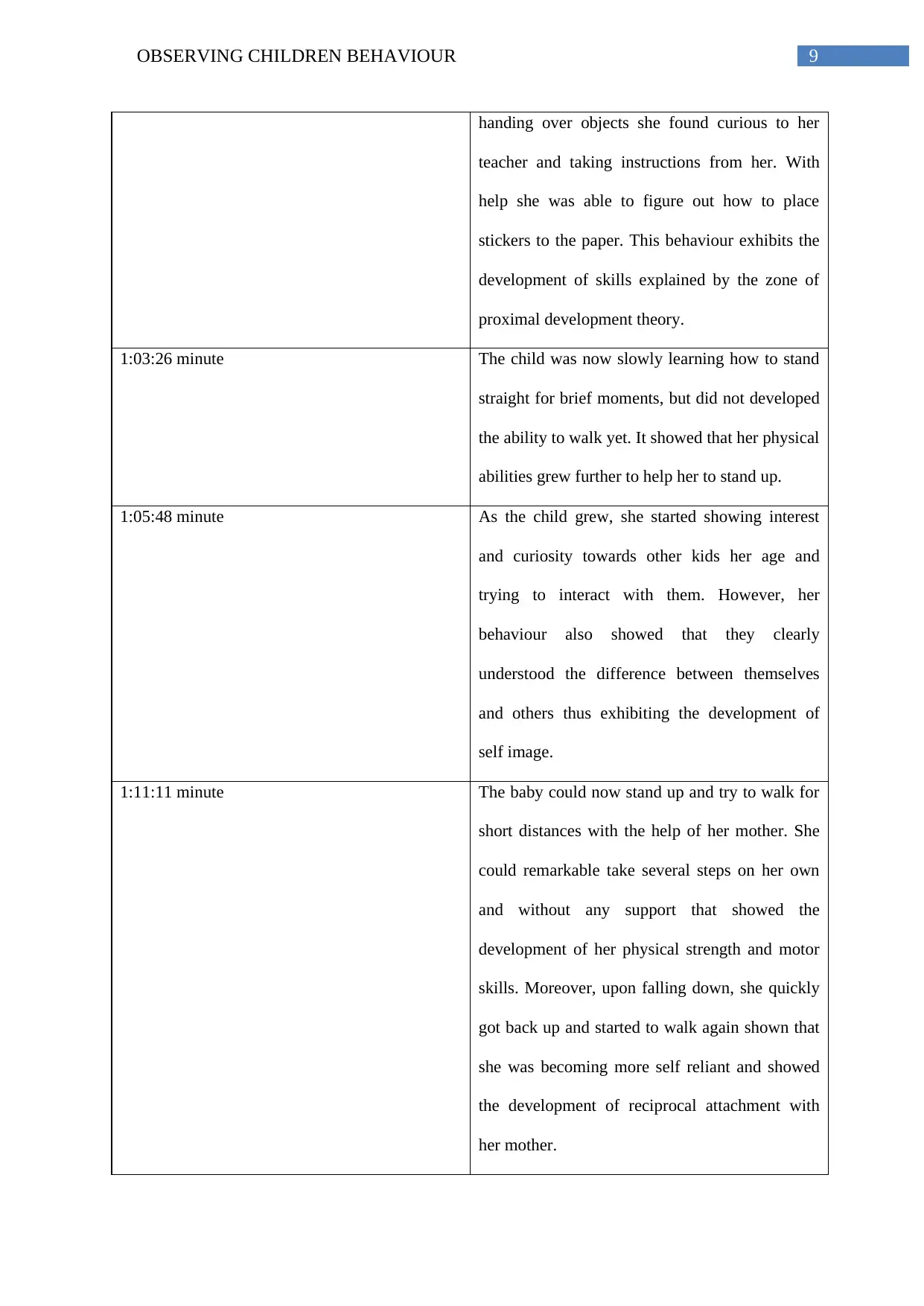
9OBSERVING CHILDREN BEHAVIOUR
handing over objects she found curious to her
teacher and taking instructions from her. With
help she was able to figure out how to place
stickers to the paper. This behaviour exhibits the
development of skills explained by the zone of
proximal development theory.
1:03:26 minute The child was now slowly learning how to stand
straight for brief moments, but did not developed
the ability to walk yet. It showed that her physical
abilities grew further to help her to stand up.
1:05:48 minute As the child grew, she started showing interest
and curiosity towards other kids her age and
trying to interact with them. However, her
behaviour also showed that they clearly
understood the difference between themselves
and others thus exhibiting the development of
self image.
1:11:11 minute The baby could now stand up and try to walk for
short distances with the help of her mother. She
could remarkable take several steps on her own
and without any support that showed the
development of her physical strength and motor
skills. Moreover, upon falling down, she quickly
got back up and started to walk again shown that
she was becoming more self reliant and showed
the development of reciprocal attachment with
her mother.
handing over objects she found curious to her
teacher and taking instructions from her. With
help she was able to figure out how to place
stickers to the paper. This behaviour exhibits the
development of skills explained by the zone of
proximal development theory.
1:03:26 minute The child was now slowly learning how to stand
straight for brief moments, but did not developed
the ability to walk yet. It showed that her physical
abilities grew further to help her to stand up.
1:05:48 minute As the child grew, she started showing interest
and curiosity towards other kids her age and
trying to interact with them. However, her
behaviour also showed that they clearly
understood the difference between themselves
and others thus exhibiting the development of
self image.
1:11:11 minute The baby could now stand up and try to walk for
short distances with the help of her mother. She
could remarkable take several steps on her own
and without any support that showed the
development of her physical strength and motor
skills. Moreover, upon falling down, she quickly
got back up and started to walk again shown that
she was becoming more self reliant and showed
the development of reciprocal attachment with
her mother.
Paraphrase This Document
Need a fresh take? Get an instant paraphrase of this document with our AI Paraphraser
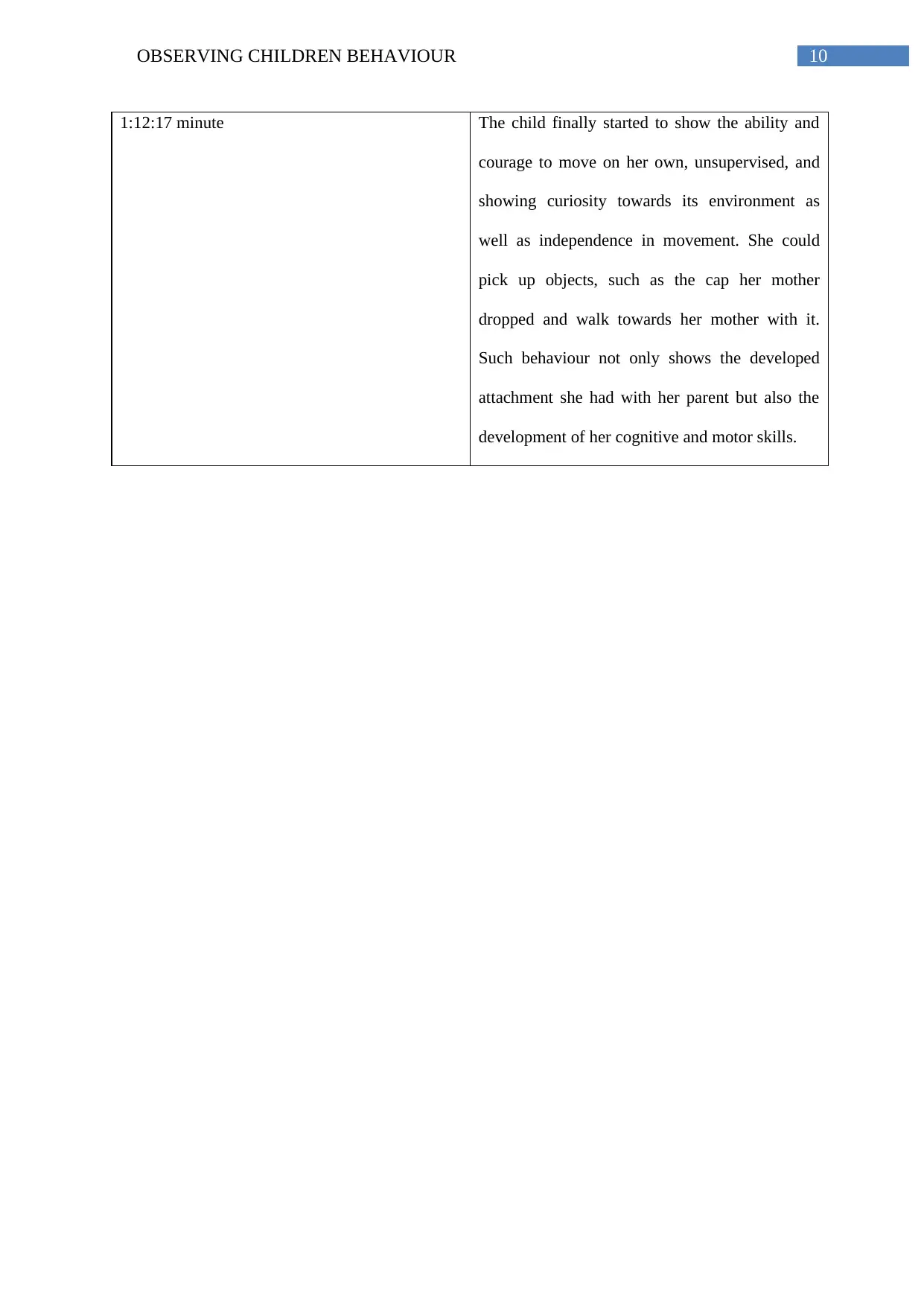
10OBSERVING CHILDREN BEHAVIOUR
1:12:17 minute The child finally started to show the ability and
courage to move on her own, unsupervised, and
showing curiosity towards its environment as
well as independence in movement. She could
pick up objects, such as the cap her mother
dropped and walk towards her mother with it.
Such behaviour not only shows the developed
attachment she had with her parent but also the
development of her cognitive and motor skills.
1:12:17 minute The child finally started to show the ability and
courage to move on her own, unsupervised, and
showing curiosity towards its environment as
well as independence in movement. She could
pick up objects, such as the cap her mother
dropped and walk towards her mother with it.
Such behaviour not only shows the developed
attachment she had with her parent but also the
development of her cognitive and motor skills.
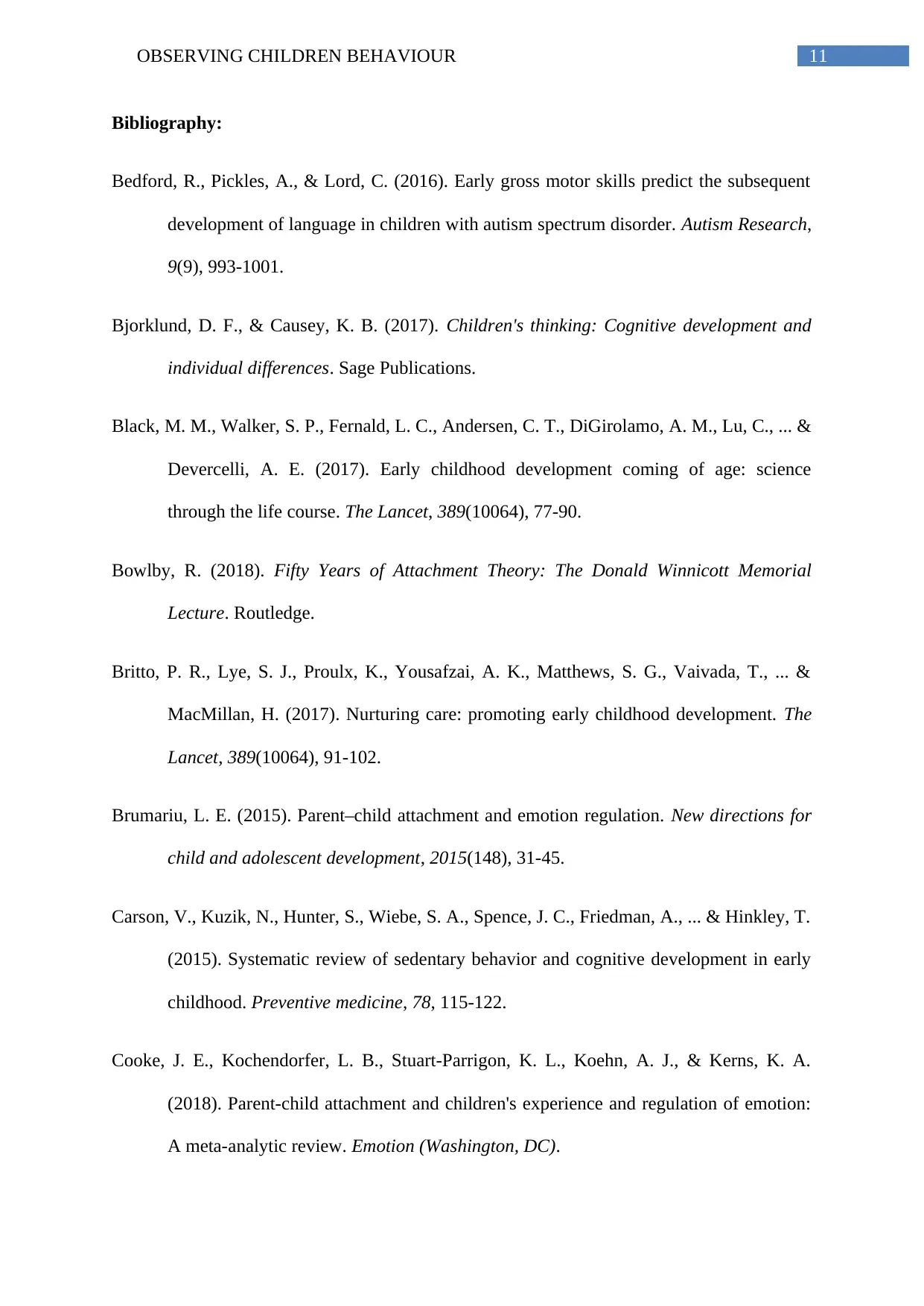
11OBSERVING CHILDREN BEHAVIOUR
Bibliography:
Bedford, R., Pickles, A., & Lord, C. (2016). Early gross motor skills predict the subsequent
development of language in children with autism spectrum disorder. Autism Research,
9(9), 993-1001.
Bjorklund, D. F., & Causey, K. B. (2017). Children's thinking: Cognitive development and
individual differences. Sage Publications.
Black, M. M., Walker, S. P., Fernald, L. C., Andersen, C. T., DiGirolamo, A. M., Lu, C., ... &
Devercelli, A. E. (2017). Early childhood development coming of age: science
through the life course. The Lancet, 389(10064), 77-90.
Bowlby, R. (2018). Fifty Years of Attachment Theory: The Donald Winnicott Memorial
Lecture. Routledge.
Britto, P. R., Lye, S. J., Proulx, K., Yousafzai, A. K., Matthews, S. G., Vaivada, T., ... &
MacMillan, H. (2017). Nurturing care: promoting early childhood development. The
Lancet, 389(10064), 91-102.
Brumariu, L. E. (2015). Parent–child attachment and emotion regulation. New directions for
child and adolescent development, 2015(148), 31-45.
Carson, V., Kuzik, N., Hunter, S., Wiebe, S. A., Spence, J. C., Friedman, A., ... & Hinkley, T.
(2015). Systematic review of sedentary behavior and cognitive development in early
childhood. Preventive medicine, 78, 115-122.
Cooke, J. E., Kochendorfer, L. B., Stuart-Parrigon, K. L., Koehn, A. J., & Kerns, K. A.
(2018). Parent-child attachment and children's experience and regulation of emotion:
A meta-analytic review. Emotion (Washington, DC).
Bibliography:
Bedford, R., Pickles, A., & Lord, C. (2016). Early gross motor skills predict the subsequent
development of language in children with autism spectrum disorder. Autism Research,
9(9), 993-1001.
Bjorklund, D. F., & Causey, K. B. (2017). Children's thinking: Cognitive development and
individual differences. Sage Publications.
Black, M. M., Walker, S. P., Fernald, L. C., Andersen, C. T., DiGirolamo, A. M., Lu, C., ... &
Devercelli, A. E. (2017). Early childhood development coming of age: science
through the life course. The Lancet, 389(10064), 77-90.
Bowlby, R. (2018). Fifty Years of Attachment Theory: The Donald Winnicott Memorial
Lecture. Routledge.
Britto, P. R., Lye, S. J., Proulx, K., Yousafzai, A. K., Matthews, S. G., Vaivada, T., ... &
MacMillan, H. (2017). Nurturing care: promoting early childhood development. The
Lancet, 389(10064), 91-102.
Brumariu, L. E. (2015). Parent–child attachment and emotion regulation. New directions for
child and adolescent development, 2015(148), 31-45.
Carson, V., Kuzik, N., Hunter, S., Wiebe, S. A., Spence, J. C., Friedman, A., ... & Hinkley, T.
(2015). Systematic review of sedentary behavior and cognitive development in early
childhood. Preventive medicine, 78, 115-122.
Cooke, J. E., Kochendorfer, L. B., Stuart-Parrigon, K. L., Koehn, A. J., & Kerns, K. A.
(2018). Parent-child attachment and children's experience and regulation of emotion:
A meta-analytic review. Emotion (Washington, DC).
⊘ This is a preview!⊘
Do you want full access?
Subscribe today to unlock all pages.

Trusted by 1+ million students worldwide
1 out of 14
Related Documents
Your All-in-One AI-Powered Toolkit for Academic Success.
+13062052269
info@desklib.com
Available 24*7 on WhatsApp / Email
![[object Object]](/_next/static/media/star-bottom.7253800d.svg)
Unlock your academic potential
Copyright © 2020–2025 A2Z Services. All Rights Reserved. Developed and managed by ZUCOL.





